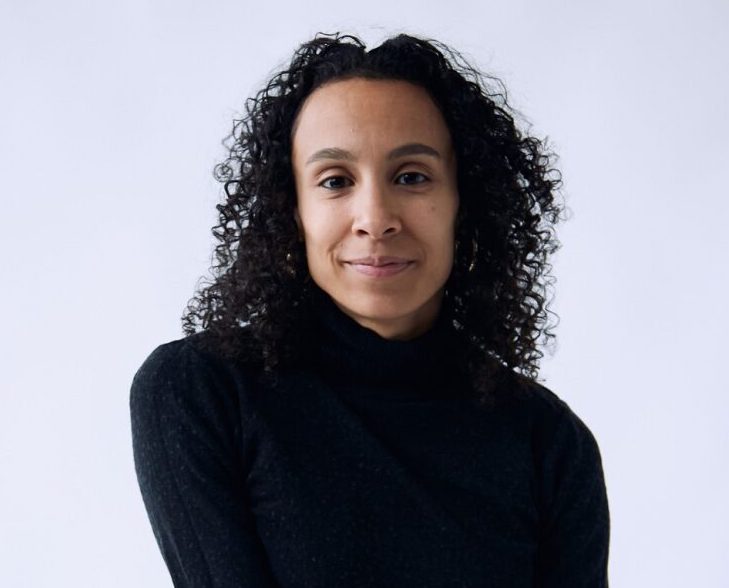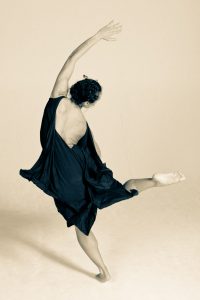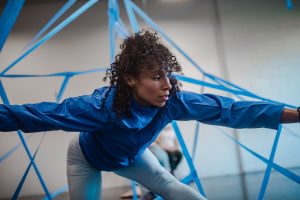
Assistant Professor of Dance Marielis Garcia has been a teaching artist since she was barely a teenager—a gutsy teenager who knew exactly what she wanted and wasn’t afraid to ask for it:
“My parents are both immigrants from the Dominican Republic and there just wasn’t a whole lot of surplus cash for extracurricular activities, so everything we did was through our public school or free. When I was thirteen, my dance class took a field trip to a studio. One of the teachers said I should take classes with them because I showed some talent. I said, ‘My parents can’t really afford this, and besides you’re just trying to make money. If you really mean it (and I don’t know where I got the courage to say this) then I’ll need some sort of work study.’”
Garcia says she didn’t really know what work study was, but the teacher did. The studio turned out to be one connected with Dance Theatre of Harlem, and so Marielis began studying and acting as an assistant with the younger students in the program to pay for her classes:
“Even back then, there was an element of teaching dance while doing my own dance. It’s never been about me singularly. It’s always been about bringing myself in as authentically as possible and sharing, which inevitably is both performance and teaching. It’s finding this two-way connection. We’re creating or facilitating spaces where we can connect. That really speaks to my pedagogical and creative approaches.”
At the Dance Theatre of Harlem, Garcia fell in love with ballet:
“I became very obsessed with dance and the balletic form, and that is very connected to a piece I’m currently making. I’ve been thinking about this young teenage girl in New York City and how there was something about the structure of ballet that helped me find ownership of my body. It wasn’t a body that stood in place as Marielis, the youngest in this family. It wasn’t a body that was raised in a particular religion. It wasn’t a body that my mom cared for. It wasn’t a body just out in the world. It was mine. I could control it. Having that structure of form and working toward this very difficult practice in relationship to grace and artistry. And I realized that two things can exist at one time. Something can be very hard, and it can also be easy. My mind was blown.”

Garcia continued studying ballet as an undergraduate at Marymount Manhattan College and began exploring other forms:
“I was being exposed to modern dance—learning the styles of choreographic greats [Martha] Graham, [José] Limón, and [May] O’Donnell. There was this whole other avenue of a practice of movement in non-performance. I started thinking about how I could be my fullest self in sharing something with my body in something that’s not language based.”
After college, Garcia danced with a company in Washington, DC for a year, then moved back to New York:
“I made the commitment to myself that I would not ever take a job that was not connected to dance. I started teaching dance in an afterschool program, which is exactly how I got started. I started making work and trying to develop my own voice.”
That’s when Garcia found yet another avenue of expression:
“I was making some digital movies, and growing up as a millennial, I was doing a bit of coding and web design. I found a master’s program in Digital and Interdisciplinary Art Practice at City University of New York and thought, ‘This is totally it!’ The influences of dance existing beyond the physical body and the relationship of dance with visual art fed me even more.”
Garcia came to UNCG’s School of Dance and the College of Visual and Performing Arts (CVPA) in fall 2023. She teaches Ballet, Contemporary, Digital, Interdisciplinary Art Practice, and Choreography. She also continues to create her own work, something she feels is strongly supported by CVPA:
“There is opportunity for financial support through programs like the Scholars’ Travel Fund. There is also great support for faculty to leave during a semester to tour with their work or do work outside of the University. It feels good to be able to commit to a project to the fullest.”

One of Garcia’s projects is Possibilities of Dialogue, “an exchange of energy and awareness. Inspired by the parallels between making a dance and having a conversation, the performance is an emergent, collaborative creative process.” Garcia was already deep into creating the piece with her friend and collaborator David Norsworthy when she started teaching in Greensboro:
“David and I started work on it in 2016 with community workshops. We started this as a way to dig into this idea of sharing an experience rather than a path of entertainment. How do we create a dance that is in conversation with conversation? One of the things that came out of developing this piece is the use of tape as a connector, a builder, and a space holder, and as a director of our experience.
Garcia describes Possibilites of Dialogue:
“It starts out as sort of a roadmap. The dancers walk through the space, and the audience does too as they find their seats. Then the tape gets pulled up and it becomes a three-dimensional landscape, and the dancers create choreography in relationship to the tape. Then the tape becomes what we call web, that’s when it gets fully lifted and the audience is holding the edges of it. Eventually the whole structure becomes an archive, which is the shared experience of what has come of this time together.”
In 2019 Possibilities of Dialogue premiered in Toronto. In 2020, Garcia and Norsworthy received funding to take it to nine cities in the United States, Canada, and South America. But the COVID pandemic stalled the tour until 2021, so travel was still on the calendar for Garcia after she was appointed to UNCG’s faculty:
“I felt so supported in this project. I was able to bring David in to do guest artist classes for School of Dance students, and when the time came to go on tour, there was just no question of me leaving my classes to do that. When there’s that kind of commitment of a university to faculty to bring their research to bring their practice into the classroom, it is a great benefit to the students.”
Garcia recently performed in New York as part of an exhibition by visual artist Sarah Crowner. That experience, too, was brought back to her classes at the School of Dance:
“My students learned that dance and visual art can be connected, and we talked about how they will be their own directors and organizers in creating work. I think sharing my performance and research experiences can give them a broader educational experience. A larger scale picture. That it’s not just about doing three pirouettes. It pulls them out of the day-to-day tasks and helps them understand that their lives in dance is a bigger concept than technique.”
Story by Terri W Relos
Photo credits: Whitney Browne (Headshot) Frank Baratta (Possibilities of Dialogue), Hope Youngblood (Garcia solo)